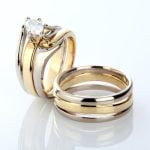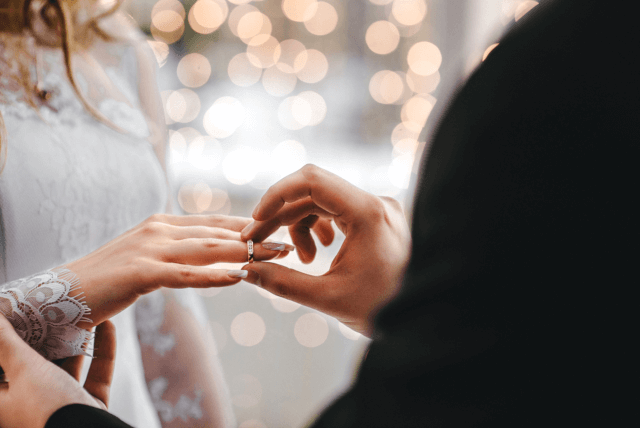When did wedding rings start? The tradition of exchanging wedding rings has a long and fascinating history, dating back thousands of years.
The symbolism behind these simple bands of metal goes beyond just a symbol of love and commitment, encompassing cultural, religious, and personal significance as well. In this article, we will explore the ancient origins of wedding rings, how they have evolved over time, their cultural significance in different societies and religions, the association of diamonds with engagement rings, modern trends and styles, famous celebrity wedding rings throughout history, and the emotional connection that individuals have with their own wedding bands.
The exchange of wedding rings is deeply rooted in tradition and has been a significant part of marriage ceremonies for centuries. It’s not just about the physical act of wearing a ring on your finger; it’s about the meaning behind it and the emotional connection it represents. From ancient customs to present-day trends, the symbolism of wedding rings continues to be an enduring tradition that holds immense sentimental value for couples around the world.
In this comprehensive exploration of the history and significance of wedding rings, we will delve into their ancient origins, historical evolution, cultural and religious importance across various societies, the rise of diamond rings in engagement settings, changing styles and designs in modern times, influential celebrity examples throughout history, and personal stories that highlight the deep emotional attachment people have with their own wedding bands. Join us on this journey through time as we uncover the timeless tradition of wedding rings.
Ancient Origins
The use of wedding rings can be traced back to ancient times, with the earliest evidence dating back to ancient Egypt. The ancient Egyptians believed that the circle symbolized eternity, with no beginning or end, making it the perfect representation of eternal love and commitment.
They would exchange rings made of braided reeds or leather, worn on the fourth finger of the left hand, which they believed had a vein that led directly to the heart, known as the “vena amoris” or “vein of love”.
In addition to ancient Egypt, there is also evidence of wedding rings being used in ancient Rome. Roman wedding rings were typically made from iron and were worn by women to symbolize ownership by their husbands. These early examples provide fascinating insights into how wedding rings have been used throughout history and the significance they held in different cultures.
Furthermore, historical evidence suggests that wedding rings were also used in ancient Greece as a symbol of unity and fidelity between partners. These early examples demonstrate that the tradition of exchanging wedding rings has deep roots in various civilizations throughout history.
| Origin | Materials Used |
|---|---|
| Ancient Egypt | Braided reeds or leather |
| Ancient Rome | Iron |
| Ancient Greece | Not specified |
Historical Evolution
The tradition of exchanging wedding rings dates back thousands of years and has evolved significantly over time. From simple bands made of natural materials to ornate designs featuring precious gemstones, the evolution of wedding rings reflects changes in culture, technology, and societal norms.
Early Civilizations and Simple Bands
Historical evidence suggests that the ancient Egyptians were among the first to use wedding rings as a symbol of eternal love and commitment. These early rings were often made from readily available materials such as reeds, leather, or braided plant fibers. The circular shape of the ring was seen as a representation of eternity, with no beginning or end, making it a fitting symbol for marriage.
Medieval Europe and Symbolic Engravings
During the medieval period in Europe, wedding rings began to feature more elaborate designs and engravings. It was during this time that the tradition of wearing the wedding ring on the fourth finger of the left hand became popular due to the belief that this finger contained the “vena amoris” or “vein of love” which was believed to be directly connected to the heart.
Rings were often engraved with romantic phrases or symbols meant to represent the bond between husband and wife.
Industrial Revolution and Mass Production
The Industrial Revolution brought about significant changes in the production of wedding rings. With advancements in technology and manufacturing processes, wedding rings became more accessible to people across different social classes. This period also saw an increase in the use of precious metals such as gold and silver for creating wedding bands, symbolizing enduring value and prosperity within marriage.
As we can see, the tradition of exchanging wedding rings has evolved significantly over time, reflecting changes in material availability, cultural beliefs, and technological advancements. Today’s modern wedding rings come in a wide variety of styles and designs, showcasing individual preferences while still honoring a timeless tradition that has spanned centuries.
Cultural Significance
Wedding rings hold a significant cultural and religious value around the world, symbolizing love, commitment, and fidelity. In many cultures and religions, the exchange of wedding rings is a timeless tradition that marks the union between two individuals. The origins of wedding rings can be traced back to ancient times, with each culture adding its unique customs and symbolism to the tradition.
Christianity
In Christianity, the wedding ring is seen as a symbol of unity and eternity. The circular shape represents eternal love without beginning or end, while the unbroken band signifies the unending commitment between spouses. The exchange of rings during a Christian wedding ceremony is typically accompanied by vows that emphasize the sacredness of marriage.
Judaism
In Jewish tradition, the wedding ring holds deep significance as well. During a Jewish wedding ceremony, a plain gold band is often used as a symbol of purity and simplicity. It is placed on the bride’s index finger to signify her willingness to enter into the marriage contract (Ketubah) with her groom.
Hinduism
In Hindu weddings, the exchange of wedding rings varies across different regions in India. One common practice is for both partners to exchange floral garlands followed by placing red powder on each other’s foreheads before exchanging rings. The significance of wedding rings in Hindu culture lies in its representation of commitment and devotion to one another.
As we explore various cultures and religions around the world, it becomes evident that wedding rings play a crucial role in not only symbolizing love but also in highlighting the values and traditions upheld by different communities. The cultural significance attached to these symbols continues to enrich the timeless tradition of exchanging wedding rings during marital ceremonies.
The Rise of Diamond Rings
The tradition of giving diamond engagement rings has become deeply ingrained in Western culture, but it has relatively modern origins. Here is how diamonds became associated with engagement rings:
- Discovery of Diamonds: Diamonds have been treasured for centuries for their beauty and rarity. The first recorded diamond engagement ring was given by Archduke Maximilian of Austria to Mary of Burgundy in 1477. This sparked a trend among the European nobility to give diamond rings as a symbol of betrothal.
- De Beers Marketing Campaign: In the late 19th century, large diamond deposits were discovered in South Africa, leading to an oversupply. To control the market and maintain high prices, the De Beers company launched a successful marketing campaign in the 20th century associating diamonds with love and commitment. Their famous slogan “A Diamond is Forever” further solidified the link between diamonds and engagement.
- Hollywood Influence: The glamour of Hollywood also played a significant role in popularizing diamond engagement rings. Celebrities began sporting stunning diamond rings and this greatly influenced societal expectations surrounding engagements and marriage proposals.
The association of diamonds with engagement rings has now become a widely accepted tradition in many parts of the world. However, the symbolism behind the giving of a diamond ring remains deeply personal and meaningful to each couple.
Modern Trends
The tradition of exchanging wedding rings dates back to ancient times, but the styles and designs of these rings have evolved significantly over the years. In today’s modern world, there is a wide array of options for couples to choose from when it comes to selecting their wedding bands. From traditional gold bands to contemporary designs featuring intricate details and precious gemstones, the options are endless.
One of the most popular modern trends in wedding rings is the use of mixed metals. Couples are opting for combinations such as rose gold and platinum or yellow gold and white gold, creating unique and personalized pieces that reflect their individual style. Additionally, non-traditional materials such as titanium, tungsten, and ceramic are also gaining popularity for their durability and modern aesthetic.
Another trend in wedding ring design is the rise of custom-made rings. Many couples are choosing to work with skilled jewelers to create bespoke wedding bands that are tailored to their specific preferences. This allows them to incorporate meaningful elements such as birthstones, engravings, or unique shapes into their rings, adding a personal touch to this timeless symbol of love.
Furthermore, minimalist and unique designs have become increasingly popular in recent years. Many couples are gravitating towards simple yet elegant styles that feature clean lines and subtle details. Delicate stackable rings, geometric shapes, and vintage-inspired designs are all examples of how modern couples are embracing individuality in their wedding ring choices.
| Modern Trends | Changing Styles |
|---|---|
| Mixed Metals | Rose gold & platinum combinations |
| Custom-Made Rings | Tailored with birthstones or engravings |
| Minimalist Designs | Elegant styles with clean lines |
These modern trends reflect the changing tastes and preferences of couples today as they seek out wedding rings that not only symbolize their commitment but also express their unique love story. As we look towards the future, it is clear that wedding ring designs will continue to evolve, offering even more diverse options for couples to cherish for a lifetime.
Celebrity Influence
Throughout history, famous wedding rings have played a significant role in influencing the styles and designs of wedding rings for the general public. From royalty to Hollywood celebrities, the iconic wedding rings of well-known figures have set trends and sparked inspiration for countless couples around the world.
Some of the most famous wedding rings in history include:
- Queen Elizabeth II’s engagement ring: Designed by Prince Philip, Duke of Edinburgh, Queen Elizabeth’s engagement ring features a three-carat diamond solitaire flanked by five smaller diamonds on each side.
- Marilyn Monroe’s eternity band: Marilyn Monroe’s eternity band from her marriage to Joe DiMaggio popularized the trend of using eternity bands as wedding rings.
- Princess Diana’s sapphire engagement ring: Originally selected from Garrard jewelry catalog, Princess Diana’s sapphire engagement ring has since become one of the most iconic and replicated engagement ring designs in history.
These famous wedding rings have not only symbolized love and commitment but have also influenced the jewelry industry and shaped modern trends. The celebrity influence on wedding ring styles has continued to play an important role in shaping the choices that couples make when selecting their own symbolic bands of commitment.
Personal Stories
Many couples have personal stories and emotional connections to their wedding rings. These rings often hold sentimental value and serve as a constant reminder of the love and commitment shared between partners. The exchange of wedding rings during the marriage ceremony symbolizes the couple’s promise to each other, and this symbolism carries through their entire marriage.
For some couples, their wedding rings may have been passed down through generations, making them heirlooms with deep family history and tradition. This connection to the past adds even more emotional significance to the rings. Others may have custom-designed rings that hold specific symbols or designs unique to their relationship. These personalized touches make the rings even more meaningful and special.
In times of hardship or distance, many individuals find comfort in wearing their wedding ring as a physical representation of their partner’s love and support. Moreover, during difficult moments, such as illness or separation, wearing the ring can provide a sense of comfort and reassurance. The emotional connection to wedding rings extends beyond just the symbol itself; it represents a tangible bond between two people that withstands the test of time.
Conclusion
In conclusion, the tradition of exchanging wedding rings has a long and storied history, with evidence of the practice dating back thousands of years. From ancient origins to modern trends, the symbolism and significance of wedding rings have remained constant throughout time. The act of exchanging rings symbolizes love, commitment, and partnership, making it a timeless tradition that transcends cultural and religious boundaries.
The evolution of wedding ring styles and designs reflects the changing preferences and tastes of each era. From simple bands to luxurious diamond-encrusted rings, the symbolism behind the exchange remains unchanged. The rise of diamond engagement rings in more recent history has further cemented the association between these precious stones and eternal love.
Personal stories of heirloom rings passed down through generations or unique custom-made designs reflect the emotional attachment people have to their wedding rings. This emotional connection serves as a reminder that the tradition is not just a symbolic gesture but also a deeply personal one for each individual.
Overall, while wedding ring styles may change and evolve over time, the emotional significance behind them remains constant. As we look back on the history and cultural significance of wedding rings, it is clear that this tradition will continue to endure for generations to come.
Frequently Asked Questions
When Did Wedding Rings Become Common?
Wedding rings became common in ancient Egypt, around 2800 BC. They were initially made of materials like reeds and hemp, symbolizing eternity and never-ending love between the couple.
When Did Diamond Rings Become a Symbol of Marriage?
Diamond engagement rings became a symbol of marriage in the late 1940s, due to a successful marketing campaign by De Beers. It was meant to promote diamonds as a status symbol and a representation of enduring love.
Did They Have Wedding Rings in the 1500s?
Yes, wedding rings were present in the 1500s, but they were not as commonly exchanged as they are now. Rings made of materials like copper or brass were often used, and their designs varied depending on cultural traditions.

Welcome to my blog about home and family. This blog is a place where I will share my thoughts, ideas, and experiences related to these important topics. I am a stay-at-home mom with two young children. I hope you enjoy reading it! and may find some helpful tips and ideas that will make your home and family life even better!





